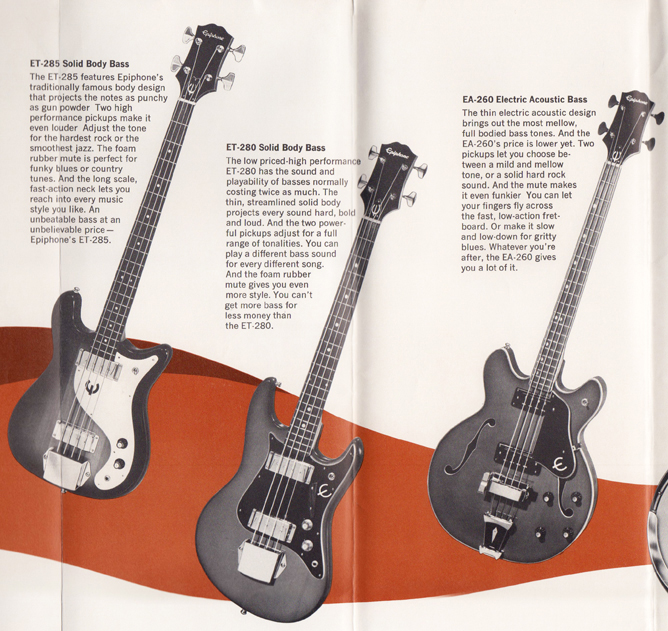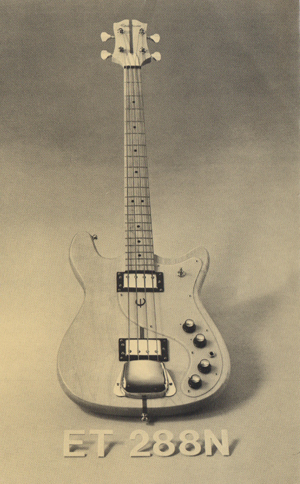
Think of vintage Epiphone bass guitars, and you probably picture a hollowbody Rivoli in the hands of a 1960s beat group. This was actually the first Epiphone electric bass; they only built upright acoustic basses in the 1950s prior to it's purchase by Gibson/CMI - in fact part of the rationale for taking over Epiphone in 1957 was to get the associated bass tooling. Today, Epiphone bass guitars are a huge part of Gibson's product line, offering several pretty accurate reissues of classic Gibson and Epiphone bass models, but at a quite affordable price point. This page is about the older Epiphone basses: those built by CMI in Kalamazoo, and those built for Norlin in the 1970s and early 1980s.
The Epiphone electric bass story begins in 1957. Once Epiphone guitar production was moved to the Gibson plant, in Kalamazoo, Michigan, new models started to appear. These were branded as Epiphones, but usually based on Gibson models, sharing hardware and Gibson construction methods, and sometimes almost identical. The point of this duplication was to allow them to be distributed to stores who wanted Gibson quality products but had not been lucky enough to be selected as the Gibson dealer for a certain area. These Epiphones were every bit as good as the Gibson guitars with which they were produced side-by-side.
The first Epiphone bass guitar was introduced in 1959: the hollow-body Epiphone Rivoli based on the Gibson EB2. It was only manufactured in small numbers, and was joined by the solid-body Epiphone Newport based on the Gibson EB0 in 1961. The Newport had it's own body and headstock shape; although functionally and tonally very similar to the EB0, it looked very different. The Rivoli was identical (excluding headstock shape and pickguard) to the EB2.
Both the Newport and Rivoli basses were short (30") scale, and in 1963, Gibson produced it's first long (34") scale model, the Gibson Thunderbird and the Newport-styled Epiphone equivalent, the Embassy Deluxe.
As the 1960s ended, American guitar companies were really struggling to compete with cheaper imports from Asian manufacturers. Epiphone production ceased at Kalamazoo in 1969, in favour of a number of similar looking, but considerably cheaper models produced by Matsumoku in Japan.
The final Epiphone price list of the 1960s (June 1968) lists the single-pickup Newport at $270, with the Rivoli at $425. The first Epiphone catalogue of the seventies (Oct 1970) lists a dual pickup solid body bass #1820 at just $115, and an electric-acoustic equivalent to the Rivoli the #5120 at $135. The price difference was simply huge.
These were both rebranded versions of guitars that had been available since 1967 - under the brands Aria, Conrad and possibly many more. The #5120 was previously sold as the 1220 bass, the #1820 kept the same model designation as used by Aria.
So just how did these models differ from the basses they were replacing? Both had the same short (30 1/2") scale, a rosewood fretboard and 20 frets, and a Cherry finish - that is about where the similarities end. The new models were dual pickup instruments (as opposed to the single pickup Rivoli and Newport) but with single coil units instead of humbuckers. The traditional set neck was replaced by a much simpler (probably maple) bolt-on. Body woods are unspecified in literature of the time, but were no longer the mahogany of the Newport, nor the maple of the Rivoli.
By 1972 these two models were renamed ET-280 and EA-260; and were joined by a third model, another dual pickup solidbody, but this time with a long (34") scale: the ET285. It had more of the styling of the original Newport, with the earlier body shape and the same characteristic scratchplate, but with the same hardware as the ET-280.

1972 Epiphone brochure showing the three models available at that time, the ET-285, ET-280 and EA-260
The forementioned models were pretty basic, hence their low prices in comparison to previous Epiphone models. The next bass to join the Epiphone line was a step up however, and was launched at the 1974 NAMM show in Houston: the ET-288N.

The Epiphone ET-288N had similar body styling to the ET-285, i.e. the familiar Newport-esque shape with overall short body and slightly extended top horn. But it had a very different construction: it featured a maple body, but with a maple through-neck, and maple fretboard, similar in construction to the earlier Gibson Thunderbird, or bearing in mind choice of woods, the Rickenbacker 4001.
It had better hardware and electronics too; it was fitted with more powerful humbucking pickups (in fact around this time the ET-285 was also upgraded to humbuckers) and separate volume and tone controls for each pickup.
As the seventies wore on, Epiphone continued this trend of favouring mid-level basses over the absolute budget instruments of 1970. The ET-280 was phased out in 1975, followed by the EA-260 in 1976. The Epiphone Scroll and Genesis ranges appeared briefly in late 1977 and 1979 respectively, each offering several guitar models and one bass. Again these were a step up in design and features, offering better quality woods and more advanced electronics.
In the early 1980s, a number of solid-body Epiphone instruments were produced in the USA once more, branded Epiphone USA. No bass models were officially offered, however at least one oddity came out of the Kalamazoo plant: the Epiphone E-3 / B-450. It was basically a Gibson G3, which was at the end of its production run, with it's bottom horn removed and the tip of the headstock reshaped. At least three examples exist - probably more.
Today, Epiphone guitars and basses are produced in China and Korea. The Epiphone bass range is greater than it has ever been, with replicas of many classic instruments widely available at reasonable prices.
$900
$659
$700
$400
$600
$700
$325
$400
$550
$500
$750
$430
$450
$375
$425
$3395
$225
$1700
$755
$2499